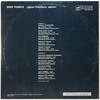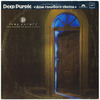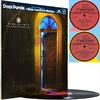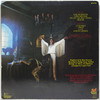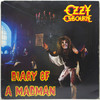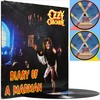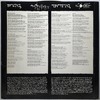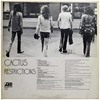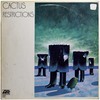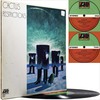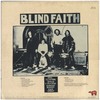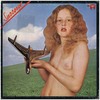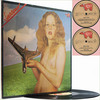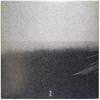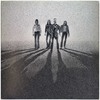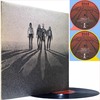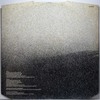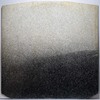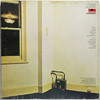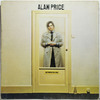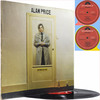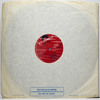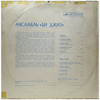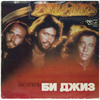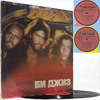Year:
1989 (LP 1990)
Label:
Melodia Records (Russia), A60 00707 000
Style:
Pop
Country:
Brownsville, Tennessee, U.S. (1939)
Time:
53:04
Format:
Flac Tracks 16/44,1 kHz
Size:
371 Mb
On Foreign Affair, it’s debatable whether Tina Turner really was “The Best”. The album, 27 years old as of Tuesday, September 13, wasn’t a major success as such in the States, considering it was her third release, post her massive comeback six years prior.
However, on the other hand, it was a huge international success in Europe, number one in Germany and Sweden, amongst other places, and topping the overall European Chart for four weeks. It was also her first UK number one album. There it sold 1.5 million copies, worldwide it sold a more than respectable total of 6 million.
With the album cover, there’s three people sat down on chairs in a triangular formation. Pointing towards the listener is Tina herself, hand in that wild hair of hers, the two others, men, pointing away north-west and north-east. These guys, perceptively, could be an Italian American mobster, big, heavy jacket and pork pie to the left; and a white, British working class man, maybe a miner or a docker, big, work worn jacket and flat cap to the right.
Does this make Turner anchored, her position between them, a black, fiery maned queen of Africa? The Third World sandwiched by the two premier exponents of First World ideology? Furthermore, because of the blue hue over the whole picture, you can’t tell if they’re sat at a sandy beach, or a snow strewn resort in the Alps, or something. Is it evoking the skies or oceans, arguably the two things universal no matter where you go?
The opening track, “Steamy Windows”, kicks in rollicking and moody, though somehow understated. This doesn’t last too long, though, when the chorus kicks in. Tina belts out her vocals and the band get a tad wild. Harmonica heralds a brief rhythm section refrain, driving and head nodding.
“The Best” comes in with that thumping bass drum and low, bassy synthesiser. Tina certainly puts her identity upon a track which was originally performed by Bonnie Tyler. It’s passionate, and it’s fair to say she spills her guts out on this one. It’s an uplifting one, and it’s easy to see why, for many, it’s her signature track.
The crescendo towards the saxophone solo, and it’s subsequent play, might bring a tear to those caught up in the histrionics of that particular moment. The bass drum and a light tinkling bring the track right down with excellent dynamics, before raising for another epic climax of sheer, searing emotion.
Track three, “You Know Who (Is Doing You Know What)”, is quite a moody number, somewhat rooted in the blues. Tell-tale signs to the contrary are the bass synthesiser, which in itself actually works quite well. Bossy and authoritative, it underpins the whole arrangement, really holding it down. Passionate, bluesy guitar, up the other end, takes flight over the top; sad, emotive and a tad triumphant.
Following track, “Undercover Agent For The Blues”, has a walking beat, so much so it’s maybe moodier and more blues inflected than anything preceding it. Tina’s vocals are definitely hot and heavy, almost personifying the identity of opener, “Steamy Windows”. Her delivery then comes straight from the gut, not too far from doing damage to those famous vocal chords of hers.
“Look Me In The Heart” is a bit more tender, though there is a rhythm akin to a galloping horse. More of a romantic lilt than anything else, though. There’s a touch of melancholy to the proceedings, with the guitar flighty and almost as light as the fluttering of a heart amidst headlong romance. Saxophone brings both the sensual and sexual.
Next up, “Be Tender With Me Baby”, is similar, a down on your luck tale probably, again, concerning matters of the heart. This rocks emphatically, considering it’s walking pace. The massive drum sound really gives the song extra punch. Her high register performance seems to quest to reach that power reached by those massive drums. A passionate guitar solo follows, like reckless love and the love of the chase.
Then comes “You Can’t Stop Me Loving You”, which’s quite a busy one, a syncopated effort that’s almost funky. Parts of it seem evocative of “I Love Rock ‘N’ Roll” by Joan Jett & The Blackhearts. Another gutsy performance, though, in tandem with some really rocking, verging on hard rock and heavy metal, guitar. Passages of keyboard lend a certain graveness to proceedings, like a stalker in denial in that you can’t stop me loving you.
“Ask Me How I Feel” has a certain element to it reminiscent of “The Best”. Not so much a blatant copy as progressive writing whereby you’d largely consider such repetition as artsy, thematic and clever. With her urging for you to ask that question implied in title, it’s like she’s shoving, angry. Like asking her a stupid or rhetorical question, or her asking you something for which there can only be one answer. Yes, she’s angry. Yes, she’s passionate about, and hacked off about, something.
The excellent “Falling Like Rain” is thumping and clapping, the drums really give the song anthemic qualities. A, yes, massive sound. The chorus is satisfying, big and bold. The keyboards are thick and ring out, each note hammered out with a degree of finality. It really grooves along.
“I Don’t Wanna Lose You” is, as the title suggests, forlorn and desperate. It ticks along, slow so you can hear every word she says as she tries to make you stay. A middle section builds to a crescendo and with a never out of place saxophone solo. The height of passion, maybe suggesting embrace, reconciliation and resolution.
“Not Enough Romance”, has processed drum, aided with sparse bass. This builds up come the chorus, the whole backdrop a lot more busy and animated. In many respects, said chorus is beautiful. Light like the aforementioned fluttering and, what’s more, strings of the heart. The build up to the final chorus reinforces that beauty.
Title track and closer, “Foreign Affair”, drives like an expensive sports car driving along winding roads on continental Europe. Foreign affair, indeed. The word, again, is moody. Rooted in the blues but updating it into an Eighties context, like what a lot of Chris Rea stuff of that era did. Saxophone lends the track extra passion before fadeout.
The album has a good mix of rock, blues and pop, arguably well exemplified by “The Best”, “Ask Me How I Feel” and “Falling Like Rain”. The pop sensibilities of “The Best” are such a grand, pop production that it really hammers home when you listen. Considering it was, originally, Bonnie Tyler’s song, she certainly made it her own. For a rough equivalent, think the stamp Whitney Houston put on Dolly Parton’s “I Will Always Love You”.
With “Ask Me How I Feel”, it’s similar in some respects, maybe a nod to artistic repetition, though the passion evident on the track is of a more aggressive, maybe confrontational nature. So much so, you feel you’re being addressed personally, the end result most likely that you retreat, tail between legs, having answered, meekly, her imploring rhetoric. She, you could argue, is channelling the grief of the blues, deep set in the soul and gut, and getting angry evermore.
“Falling Like Rain”, with that big sound, fills, you could say, arenas in a way, maybe due to the rock instrumentation, that “The Best” just couldn’t cut. It’s a primal thing, probably due to the drums instead of relying upon, however bold, that bassy synthesiser of the latter.
Tina Turner’s now, for a very long time now, an international treasure. She’s bold, brassy, a real fighter, but still has a vulnerability that lends itself towards excellent songs and excellent performances.
(Posted on September 18, 2016 by Andrew Watson. www.wepluggoodmusic.com)
01. A1 Steamy Windows (04:07)
02. A2 The Best (05:32)
03. A3 You Know Who (Is Doing You Know What) (03:48)
04. A4 Undercover Agent For The Blues (05:23)
05. A5 Look Me In The Heart (03:46)
06. A6 Be Tender With Me Baby (04:19)
07. B1 You Can't Stop Me Loving You (04:02)
08. B2 Ask Me How I Feel (04:52)
09. B3 Falling Like Rain (04:07)
10. B4 I Don't Wanna Lose You (04:23)
11. B5 Not Enough Romance (04:07)
12. B6 Foreign Affair (04:30)
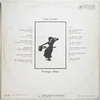
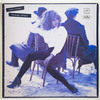


KatFile
TurboBit
PixelDrain
UploadRar
Mega4up











